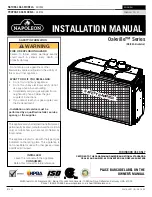
P Traps
When using the chimney air kit (CAK) and the outside air
kits, it is recommended that you install a P trap as shown
in Figure 6.4 by bending the flex duct, or using 90° elbows
iif using rigid duct to help prevent air circulation when the
fireplace is not in use. In colder climates, it is strongly
recommended to use an insulated duct.
Figure 6.4 P Trap Installation Using Flex Pipe
Typical Outside Air
Installation
Typical CAK Installation
Seal
Seal
24” (610 mm) min.
48” (1220 mm) max.
Note: The pipe
cannot lay on top
of the unit.
4” Duct-Use UL181
Class 0 or Class 1
ducting
Recommend
around 24 inches
for a minimum bend
D. Secure Offset/Return
When offsets and returns are joined to straight pipe sec-
tions, they must be locked into position with screws (outer
only). To prevent gravity from pulling the chimney sections
apart, the returns and the chimney stabilizers have hanger
straps for securing these parts to joists or rafters. See Fig-
ure 6.5.
* Use # 6 or # 8 sheet metal screw, or larger, no longer
than 1/2 in. (13 mm).
WARNING! Risk of Fire!
• Secure offsets with screws (not to exceed 1/2 in./13 mm
In length).
• Secure returns with strapping.
• Straight chimney sections may be secured with screw
(not to exceed 1/2 in./13 mm In length) at the joints.
• Keep chimney sections from separating or twisting.
Ceiling
Firestop
Straps
Optional
Additional
Support
Joint
Band
(Optional)
Figure 6.5 Secure the Chimney
WARNING! Risk of Fire!
• The flex pipe must never be compressed or deformed!
• Restricting the airflow inside the flex pipe may increase
flue pipe temperatures causing a chase fire.
30
Quadra-Fire • PIONEER - III • 4182-901 Installation Manual • Rev C • 07/19
















































